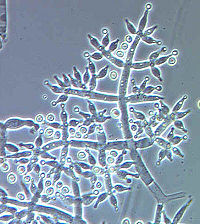
Photo from wikipedia
Endophytes can generate a cornucopia of marvelous bioactive secondary metabolites useful for mankind but their biodiversity and associations with host plants are still elusive. In this study, we explored the… Click to show full abstract
Endophytes can generate a cornucopia of marvelous bioactive secondary metabolites useful for mankind but their biodiversity and associations with host plants are still elusive. In this study, we explored the culturable endophytic microorganisms associated with 14 medicinal plants that are of high socio-economic value and/or reportedly endemic to northern Vietnam. Specifically, we isolated the endophytic microorganisms by applying surface sterilization methods and identified them based on morphological and rDNA sequence analyses. Agglomerative Hierarchical Clustering (AHC) and Principal Component Analysis (PCA) were used to analyze the correlations between the taxonomic affiliations of the culturable endophytes and the characteristics of their hosts. Most of the culturable endophytes obtained were bacteria (80), and few of those were actinomycetes (15) and fungi (8). Many of them are reported to be endophytes of medicinal plants for the first time. A number of plants (5) are also reported for the first time to contain microbial endophytes, while some plants with powerful pharmaceutical potential harbor unique endophytes. Furthermore, our results reveal a strikingly close relation between the compositions of bacterial and fungal isolates from plants having anti-bacterial activity and those from plants having anti-inflammatory activity, or between the compositions of the microbial endophytic isolates from plants having anti-cancer activity and those from plants having antioxidant activity. Altogether, the results provide new findings which can be inspiring for further in-depth studies to explore and exploit the relationships between medicinal plants and their associated endophytes in northern Vietnam and world-wide.
Journal Title: Current microbiology
Year Published: 2022
Link to full text (if available)
Share on Social Media: Sign Up to like & get
recommendations!